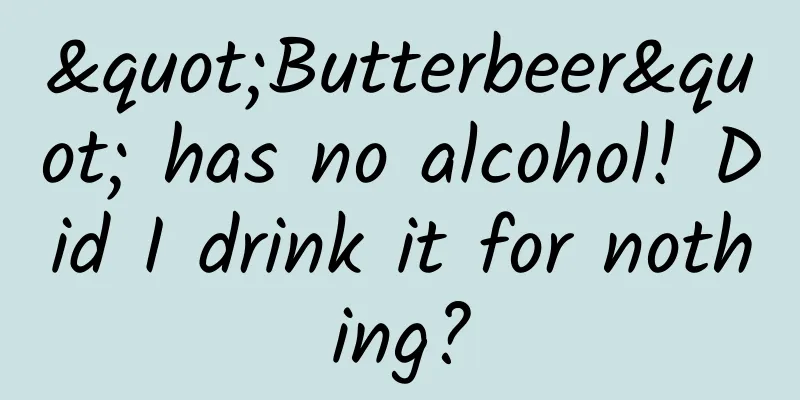"Butterbeer" has no alcohol! Did I drink it for nothing?

|
"Butterbeer" may be a magical drink that every "Harry Potter" fan wants to try. In the original work, it is a "national drink" that everyone from the respected old headmaster to the 13-year-old wizard can drink - that is, the so-called "butterbeer" may be a non-alcoholic "non-alcoholic wine". Source: thrillist.com We have all heard of sugar-free cola. In short, it uses xylitol or other sugar substitutes that are not easily absorbed by the human body to replace free sugars that are prone to cause tooth decay, obesity, and high blood sugar. Therefore, "sugar-free" is considered a healthy trend. Then, what about non-alcoholic wine? Is it non-alcoholic wine as long as it does not contain alcohol (ethanol)? The World Health Organization has long classified alcohol as a Class I carcinogen, and it can be said that "every drop of alcohol is carcinogenic." Non-alcoholic wines, which are labeled as better-tasting and healthier, have gradually become popular in recent years. So, are the production processes of these wines the same as those of ordinary wines? 1. What is non-alcoholic beer? In most EU countries and international standards, beer with an alcohol content of less than 0.5% (alcohol volume percentage below 0.5%) can be called non-alcoholic beer, while beer with an alcohol content of less than 1.2% can be called low-alcohol beer. Between 1919 and 1933, the ban on alcohol consumption stimulated the production of low-alcohol beer in the United States. In the United States and the Arab region, non-alcoholic beer means the absence of alcohol. my country's standards are the same as international standards, and beer with an alcohol content of less than 0.5% can be called non-alcoholic beer. Source: A shopping website The earliest non-alcoholic beer in history can be traced back to the 1890s, when it was first introduced by Germany (some believe it was Switzerland), followed by the United States, Britain, Japan and other countries. In China, the Guangdong Jiangmen Beverage Factory introduced China's first non-alcoholic beer production line in 1985. 2. How is non-alcoholic beer made? Currently, there are two main methods for producing non-alcoholic beer in the world. 1. Limiting fermentation The basic principle of fermentation is to use the catalytic effect of yeast to convert sugars into ethanol. Therefore, if this catalytic effect can be reduced, or the conditions for yeast to produce alcohol are not met, the purpose of reducing the alcohol content can also be achieved. Cold contact fermentation and specific yeast fermentation Let's first look at the first category, which uses a method to reduce the catalytic effect of yeast. Cold contact fermentation is to reduce the catalytic effect of yeast by controlling the temperature of the yeast fermentation environment. When the ethanol content of the yeast at normal fermentation temperature reaches the requirement, the temperature is quickly reduced to 0°C. At this time, the yeast fermentation produces less ethanol. At the same time, the aromatic substances such as isopentanol and ethyl phenyl ester produced by fermentation also make the non-alcoholic beer have the characteristics of ordinary beer in flavor. Specific yeast fermentation means specially selecting "picky" and "lazy" yeasts. These yeasts only have a special liking for fructose, glucose and sucrose, and ignore other sugars, which also reduces the production of ethanol. The second method of reducing the amount of fermentable sugar is to reduce the raw materials for yeast fermentation. By making wort at high temperatures, the amylase that converts starch into fermentable sugar is destroyed, thereby reducing the content of fermentable sugar and achieving the purpose of limiting the alcohol content. Source: Literature "Research Progress on Low-Alcohol and Alcohol-Free Beer Production Methods" 2. Remove the ethanol produced by fermentation In the production process of non-alcoholic beer, the ethanol produced in the fermentation process can be selectively removed through distillation, evaporation, dialysis, reverse osmosis and other processes. Among them, distillation and evaporation are thermal medium methods, which may damage and reduce the flavor of beer during the heat treatment process and greatly affect the taste of beer. The effect of thermal dealcoholization on beer quality mainly depends on the evaporation temperature and exposure time, which is related to the structure of the heat separator. At present, centrifugal and falling film evaporation separators have been used in industry. Dialysis and reverse osmosis belong to membrane media methods. This method has the least damage to the flavor of beer. The process will hardly cause thermal damage to the beer, but it has high requirements for equipment, so the cost is relatively high. Membrane technology is the development trend of producing alcohol-free beer in the future. Source: Pixabay In addition, in order to improve efficiency, some industrial beer production companies often dilute high-alcohol beer to obtain ordinary products, that is, add water. This step can certainly obtain low-alcohol water beer, which is simple and extremely low-cost, but there is no doubt that the product obtained in this way can hardly be called beer. By the way, from the above we can know that "non-alcoholic wine" is an alcoholic beverage obtained through fermentation, and in fact butterbeer is a beverage made with ingredients such as butter and brown sugar, so butterbeer only has the word "wine" in its name, and it is still inappropriate to call it "non-alcoholic wine". 3. Can I drive after drinking non-alcoholic liquor? Since the alcohol content of non-alcoholic alcohol is so low, some old drinkers are wondering: If they choose to drink "non-alcoholic red wine" or "non-alcoholic beer", can they break the common sense of "don't drink and drive, don't drive after drinking"? According to the investigation and verification of the public security organs, this beautiful fantasy has been broken. Source: Internet The cases investigated by the Beijing Traffic Management Bureau also show that some drivers were suspected of drunk driving due to drinking non-alcoholic beer. The standard for drunk driving is 20 mg of alcohol per 100 ml of blood, which is equivalent to the amount of a glass of beer. Although non-alcoholic alcohol can control the alcohol content below 0.5 degrees, drinking more than two bottles is enough to meet the standard for drunk driving. Everyone still cannot have a fluke mentality. Even if a small amount of non-alcoholic alcohol is consumed, the value does not meet the standard for drunk driving, but the decline in brain reaction and judgment will also affect the driver. Therefore, no matter what kind of alcohol you drink, stick to the principle of "don't drink and drive, don't drive after drinking"! |
>>: National Nutrition Week | These good dietary habits will help you eat healthily
Recommend
APP Promotion: Practical Thoughts on Low-Cost Growth of Financial Apps!
Scenario—Creativity—Benefit Point—Cycle—Channel, ...
A few branches serve as a nest, and the bird lays eggs anywhere. This bird is really a jerk.
Some time ago, citizens often shared interesting ...
SEM promotion word selection and expansion methodology can greatly improve ROI!
This article covers: Keyword division dimensions,...
@If you often watch short videos, your brain may be affected!
To reduce the time spent on short videos and get ...
An underground tunnel was found in a giant crater on the moon, which may become an ideal site for a lunar base | Expo Daily
There may be a tunnel leading underground in the ...
Hackers are Time Magazine's 2016 Person of the Year: Why
This fall, hackers took millions of Americans off...
A brief analysis of precise audience targeting in Internet advertising!
With the development of Internet advertising tech...
Qin L and Haibao 06 have received a lot of orders. Who is more panicked, the three Japanese giants or domestic competitors?
How crazy can the orders for a car be? You know, ...
How is it different from Alipay and WeChat? A detailed experience of the Digital RMB App
Finally, the region where I live has also started...
How are the ever-changing patterns on animals formed?
Abstract: The physical processes used to remove d...
What test does the graphics card have the highest power consumption? These 20 items can give you the answer
Recently, many netizens have questioned our graphi...
The core strategy of brand planning and promotion!
Previously, a netizen who is a planner came to me...
When doing short video live streaming, how can you obtain real short video industry information?
When making short videos , you often hear two voi...
37 truths about marketing promotion
Marketing is a major writing topic for my officia...
How long will it take to remove the credit blacklist?
How is the credit blacklist generated? In daily l...









